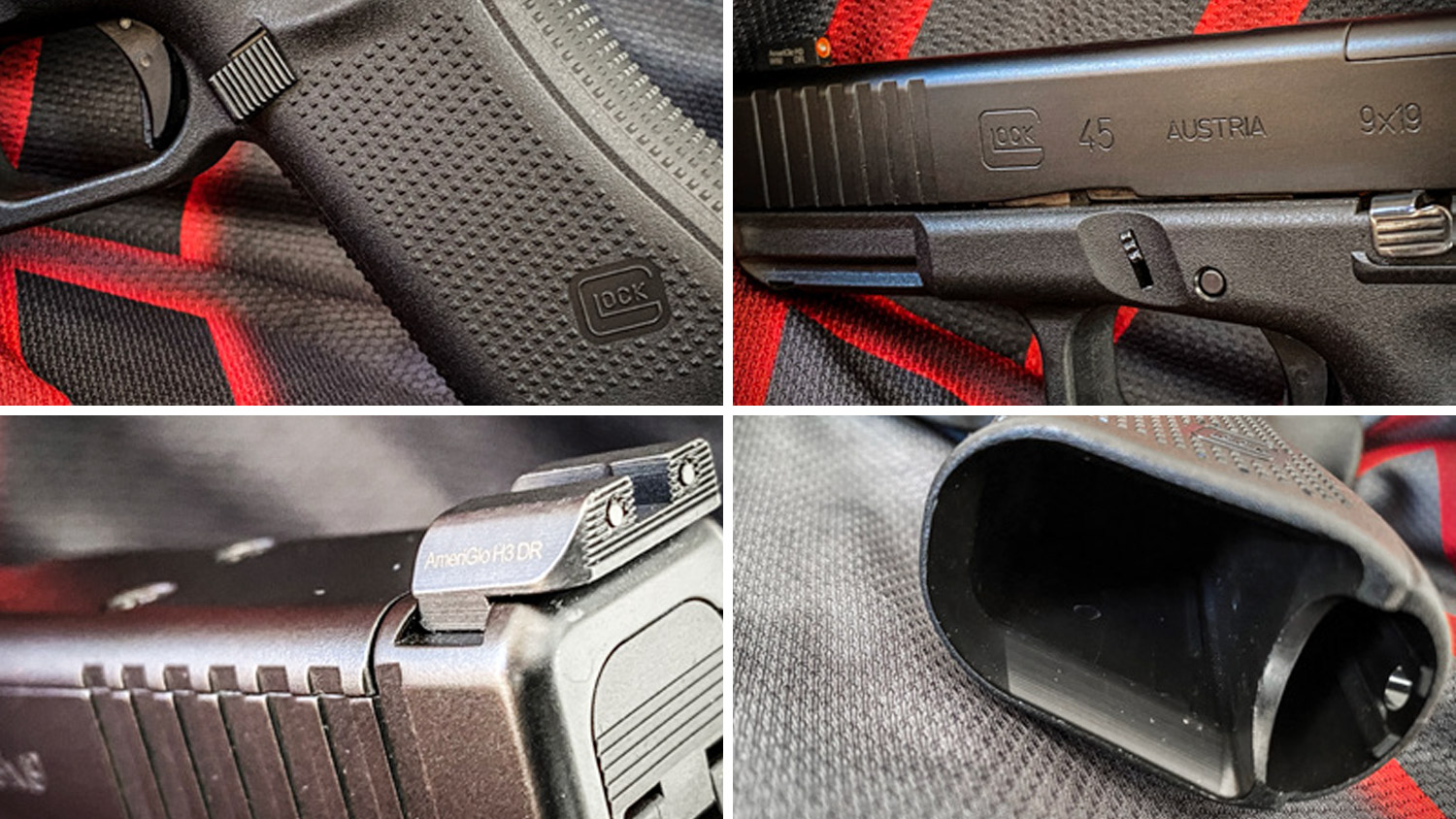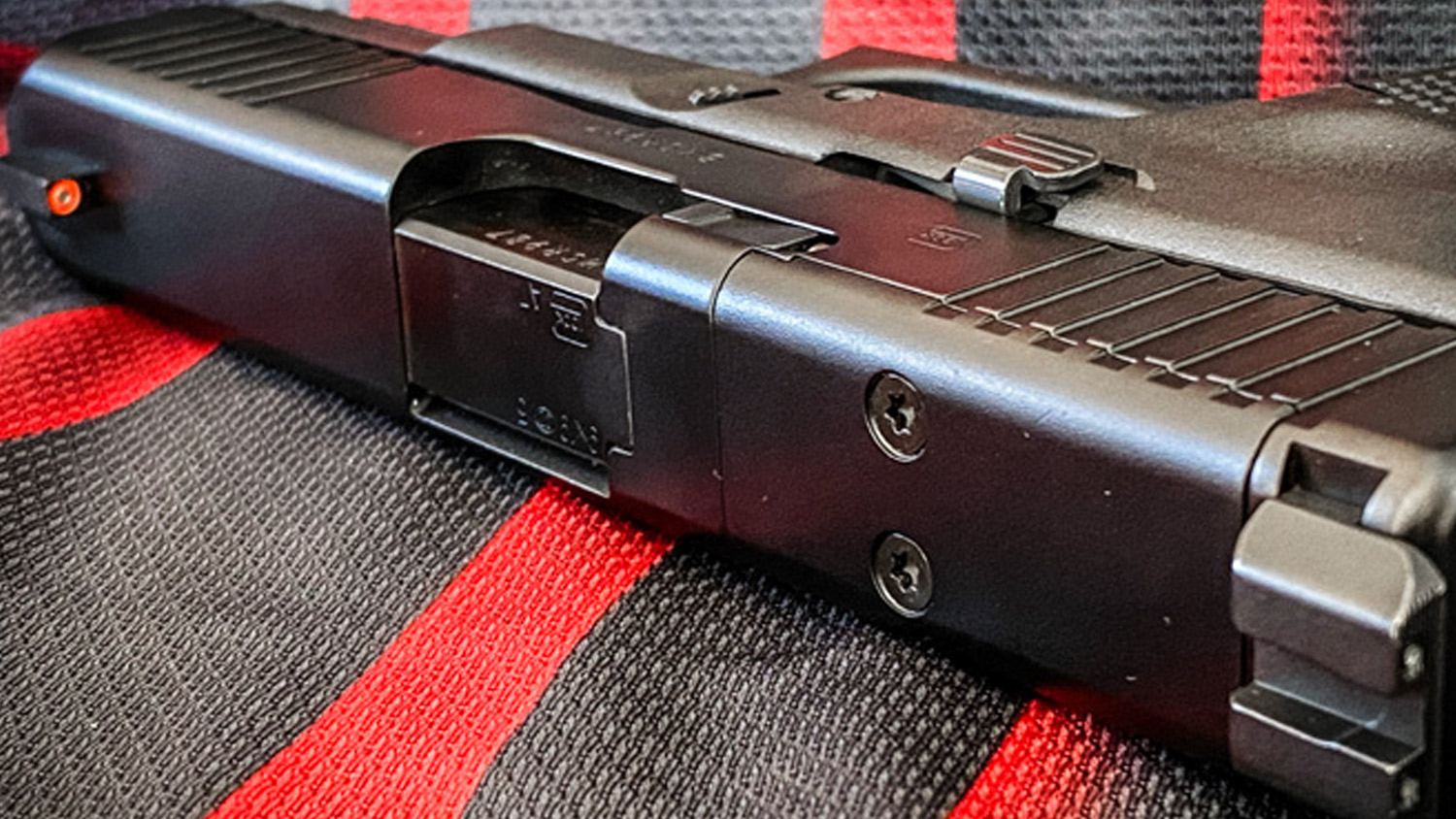
At first glance, the Glock G45 Gen5 MOS ($620, Glock.com) looks like a Glock G19, but that is not the case. The barrel length is 4.02 inches, the same as the G19, but the frame is full size and the slide has serrations on the front end. Upon closer inspection, the G45 has some very different features from the standard Glock pistol.

First, the iron sights are not your typical Glock sights. The front sight has a bright orange dot, and the rear sight is solid black without the white U-shaped line that is usually found on Glock sights. The rear sight protrudes just past the back of the slide, and the front edge of the rear sight is flat so it can be racked with one hand. For example, in a carry situation the rear sight could be hooked on a belt or holster and the slide racked, should the other hand be busy blocking strikes or grappling.
The rear sight is much sturdier than the traditional Glock sights, perhaps manufactured with serious EDC usage in mind. The rear sight sits behind the MOS plate so that the iron sights are not missing when an optic is attached. Front serrations provide good traction for slide racking. With both ends of the slide being serrated there are multiple options for racking the slide.
The trigger guard and grip are classic Glock. The magazine well is slightly flared open to facilitate easier reloads, which is a great feature. The back strap is adjustable and the magazines hold 17 rounds. The slide release is ambidextrous and the light rail is the standard Glock type.

When I first looked at this pistol, I thought, “This looks like a good carry gun to me.” After putting the pistol through its paces on the range, I know it is a great carry gun. If you are a Glock person, this gun would be a great carry gun right out of the box; if you are thinking of Carry Optics as a division, this gun would also fit into those plans very well.
We had the G45 out for a day on the range in late October and it performed without a hiccup of any kind. We shot a variety of ammunition manufactured by Federal and SIG, and the Glock ran through them all like a buzz saw through soft wood. Neither Jake Martens or myself are typically Glock guys and therefore did not have a proper holster, so we worked around the problem with sub-optimal holsters—so keep that in mind while looking at the times on these drills. I used a Blade Tech holster for a Glock G34 and the fit was a little too snug to allow for a good draw stroke. All of these drills were run with iron sights only.

The first drill was a six shot drill with three targets. The targets were from left to right sitting at distances of 10, 19 and 15 yards. Targets were spread out about 15 yards from the left and right position. We started with the gun on the table unloaded, shot the left, then the right and finished on the middle target in order to test the gun through some large transitions, shooting at the popular classic targets. Jake’s first run was 18 points in 5.05 seconds for a hit factor of 3.5643, followed by 24 points in 6.13 seconds for a hit factor of 3.9151. My first run was 5.03 seconds and 18 points on target for a hit factor of 3.5785; my second run was a little better with 24 points in 4.92 seconds for a hit factor of 4.8780. Jake said, “You should have been shooting Glock for years.” The flared magazine well worked nicely for an unloaded start, and the orange front sight was quite visible throughout our drills.
The next drill was a simple “Front Sight Forward” 6-round speed shoot. The classic targets were 10 yards distant and one yard apart. Jake gripped it and ripped it on both runs, 18 points in 2.91 seconds for a hit factor of 6.1855 and 18 points in 2.87 seconds for a hit factor of 6.2717. My first run was 3.47 seconds with 27 points on target for a hit factor of 7.7809; my second attempt was 2.99 seconds with 26 points for a hit factor of 8.6956. My draw times were 1.49 and 1.43 seconds, but with a proper holster, those should improve to a noticeable degree. The orange front sight was easy to follow across the array, and shot calling was not a problem. Sights that you can see are a big part of the recipe for success.

Our last drill of the day was a “Near to Far” array. The targets were at 10, 15 and 25 yards. We each had a speed focus rather than a front sight focus, so the times were fine but the hits suffered. We each shot three times on this array and we both were successful at getting all six hits once. Jake posted times of 3.98, and 4.31 and 4.00 seconds respectively, and his best point total was 22 points on target. My times were 4.13, 4.13 and 4.15 seconds; my best was 20 points, but I did not zero any of the runs. On my first attempt I knew the second round on the distant target was not going to be on the target. The front sight was hovering off to the right and above the target far enough that not even my flinch could get it on target, but I pulled the trigger anyway. My point is I could see the sights well enough but was not disciplined enough to be patient and let the sights settle.

The Glock G45 was a solid pistol and a steady performer. If you are in the market for an EDC gun, give it a serious look. There is nothing lacking about this gun in that role. It would require some work on the trigger for any serious competitive shooter, but with a trigger job this gun will serve you well in the Carry Optics division. The person who wants to compete in Carry Optics with the actual gun that they plan to carry should give the Glock G45 a try. The Glock G45 is much lighter than several of the more prolific guns in Carry Optics division, and therefore more likely to be used daily and not just at matches. It is fair to say that a good shooter would not be under-gunned with the Glock G45 in Carry Optics. The track record of Glock in competition over the years has proven that the brand can compete with any other.
Article from the January/February 2020 issue of USPSA’s FrontSight magazine. Photos by Isabel Martens.
See more: 9 Things I Learned From My First USPSA Match


































